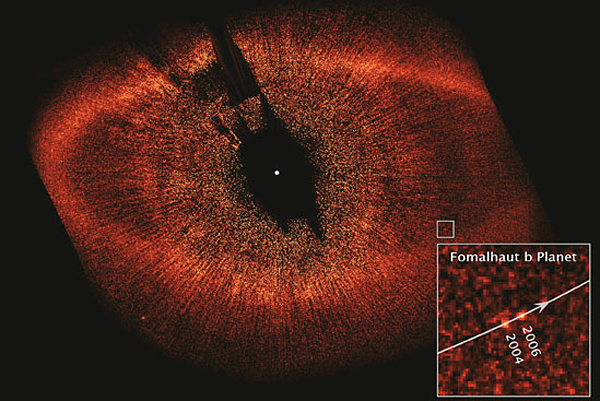 PLANET PLOTTING: An image from the Hubble Space Telescope shows the dust ring around the star Fomalhaut, where (insert) a new planet, called Fomalhaut b, was unknowingly imaged in 2004, and then noticed in 2006 when a second image showed it had moved in its orbit (Photo: NASA).
PLANET PLOTTING: An image from the Hubble Space Telescope shows the dust ring around the star Fomalhaut, where (insert) a new planet, called Fomalhaut b, was unknowingly imaged in 2004, and then noticed in 2006 when a second image showed it had moved in its orbit (Photo: NASA).In 1630, Galileo peered through his small telescope in Italy, and became the first person in history to see the soft blue light of the planet Neptune.
But he ignored it.
Galileo was instead caught up in the much more impressive sight of Jupiter, and he assumed that beautiful blue dot was just some star in the background. He made a note of the dot in his logs, and so Neptune disappeared from human sight for another 200 years.
It wasn’t until 1821 that another astronomer, Alexis Bouvard, noted that the planet Uranus was not following the orbit it should, and so predicted that another planet of a certain size and position must exist beyond Uranus. In 1846, Neptune was found, again, right where Bouvard had predicted.
For the almost two centuries since, no astronomer has so accurately predicted a planet that was later directly seen—until now, when Alice Quillen of the Department of Physics and Astronomy has made it happen again.
“It’s remarkable,” says Eugene Chiang, associate professor of astronomy at the University of California at Berkeley, and part of the team that imaged the new planet around a nearby dusty star called Fomalhaut. “Alice saw the way the inner edge of the dust ring cut off sharply and recognized that a planet likely orbited just inside. The orbit we found was amazingly close to Alice’s prediction.”
“This is a terrific achievement that showcases Alice’s many talents,” says Nick Bigelow, chair of the Department of Physics and Astronomy. “Just think, it has been over 160 years since the presence of a planet has been inferred and so quickly imaged, and that was a planet orbiting our own Sun, not a star hundreds of trillions of miles away. Extraordinary.”
In 2006, Quillen predicted that a planet of a particular size and orbit must lie within the ring of dust surrounding Fomalhaut, one of the brightest stars in the sky. The dust and debris left over from its formation form a disk larger than our entire solar system. Quillen calculated that a planet had sculpted the ring from the dust cloud, and on November 13, Chiang and his colleagues announced they had discerned a faint image of a planet right where Quillen said it should be.
More than 300 planets have been discovered around other stars, but this November’s discovery is the first to reveal actual planet images, rather than just data. For instance, in 2004, astronomers predicted the existence of a planet around a sun-like star 212 light years away, and though the planet’s presence was confirmed, it was never seen. Pluto is also frequently credited as the last planet to be predicted before being photographed, and though the original prediction did suggest that a planet may lie beyond Neptune, it did not predict Pluto’s size, orbit, or position correctly.
Quillen is now one of the world’s experts in predicting planet size and position from the features of a star’s dust ring. She used Hubble Space Telescope images that revealed that the ring of dust surrounding Fomalhaut was off-center and surprisingly sharp-edged. That edge, Quillen calculated, demanded that a relatively small, Neptune-size planet was tucked right up against the inner side of the ring, using its gravity to toss out of orbit the dust in the area.
According to Quillen’s calculations, the ring is elliptical because the planet’s orbit around Fomalhaut is also elliptical—a curiosity in such a young system. When stars form from a giant cloud of gas and dust, the angular momentum of the cloud carries over to all the objects that form from the cloud, including new planets. Those new planets should initially orbit in roughly circular paths—not elliptical ones. Fomalhaut’s ring is offset by 1.4 billion miles, more than 15 times the distance from the Earth to the Sun, which suggested that the hidden planet’s orbit is also tremendously skewed.
Quillen is continuing to search for planets and explore the way they shape stellar dust disks, though she says she hopes it will take her less than 160 years to find the next one.
Jonathan Sherwood ’04 (MA) is a senior science writer for University Communications.
